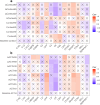Type 2 Diabetes Mellitus Aggravates Complement Dysregulation and Affects Cortisol Response in Patients with Post-COVID-19
- PMID: 39449862
- PMCID: PMC11499617
- DOI: 10.2147/DMSO.S480457
Type 2 Diabetes Mellitus Aggravates Complement Dysregulation and Affects Cortisol Response in Patients with Post-COVID-19
Abstract
Purpose: COVID-19 viral infection results in dysregulation of the complement system and a decrease in cortisol and adrenocorticotropin hormone (ACTH) levels. This study aimed to explore the complement system, as well as cortisol and ACTH responses in patients with post-COVID-19 conditions (PCC) and type 2 diabetes mellitus (T2DM).
Patients and methods: This study recruited 31 patients with PCC and T2DM (PCC-T2DM), 19 patients with PCC (PCC), 10 patients with T2DM (T2DM), and 10 healthy participants (control). Cortisol and ACTH in the PCC and PCC-T2DM groups were assessed using the insulin tolerance test. In the fasting state, serum samples were collected for proteomic analyses. Spearman correlation analysis was performed between proteins and cortisol, as well as between proteins and ACTH.
Results: Cortisol and ACTH levels were consistently decreased in the PCC and PCC-T2DM groups. Proteomic analyses revealed that most of the differentially abundant proteins (DAPs) in the PCC vs control and PCC-T2DM vs T2DM were involved in the coagulation and complement cascade, and the essential complement C3 was significantly upregulated in the PCC and PCC-T2DM groups when compared to their controls. Additionally, complement-related DAPs in the PCC vs control and PCC-T2DM vs T2DM were significantly correlated with cortisol and ACTH levels. In comparing PCC-T2DM samples with PCC samples, we found that upregulated DAPs were linked to the complement system and other immune system, and most DAPs were negatively correlated with cortisol and ACTH.
Conclusion: Our study revealed that T2DM exacerbated dysregulation of the complement system in patients with PCC, and significant correlations were present between complement protein levels and those of cortisol and ACTH. These results provide novel insights into the dysregulation of complement and endocrine hormones in patients with PCC and T2DM.
Keywords: adrenocorticotropin hormone; complement; cortisol; post-COVID-19 condition; type 2 diabetes mellitus.
© 2024 Ji et al.
Conflict of interest statement
The authors report no conflicts of interest in this work.
Figures





Similar articles
-
Morning cortisol is lower in obese individuals with normal glucose tolerance.Diabetes Metab Syndr Obes. 2011;4:347-52. doi: 10.2147/DMSO.S23915. Epub 2011 Sep 7. Diabetes Metab Syndr Obes. 2011. PMID: 21969806 Free PMC article.
-
Adrenocortical System Hormones in Non-Critically Ill COVID-19 Patients.Acta Endocrinol (Buchar). 2021 Apr-Jun;17(1):83-89. doi: 10.4183/aeb.2021.83. Acta Endocrinol (Buchar). 2021. PMID: 34539914 Free PMC article.
-
A comparison between the 1-microg adrenocorticotropin (ACTH) test, the short ACTH (250 microg) test, and the insulin tolerance test in the assessment of hypothalamo-pituitary-adrenal axis immediately after pituitary surgery.J Clin Endocrinol Metab. 2000 Oct;85(10):3713-9. doi: 10.1210/jcem.85.10.6879. J Clin Endocrinol Metab. 2000. PMID: 11061529 Clinical Trial.
-
Different Complement Activation Pathways Underly Cognitive Impairment and Type 2 Diabetes Mellitus Combined With Cognitive Impairment.Front Aging Neurosci. 2022 Mar 8;14:810335. doi: 10.3389/fnagi.2022.810335. eCollection 2022. Front Aging Neurosci. 2022. PMID: 35370615 Free PMC article.
-
Evidence for a hypothalamic-pituitary versus adrenal cortical effect of glycemic control on counterregulatory hormone responses to hypoglycemia in insulin-dependent diabetes mellitus.J Clin Endocrinol Metab. 1996 Feb;81(2):684-91. doi: 10.1210/jcem.81.2.8636289. J Clin Endocrinol Metab. 1996. PMID: 8636289
References
LinkOut - more resources
Full Text Sources
Miscellaneous

